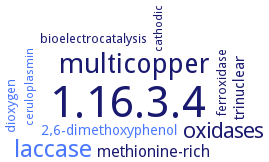1.16.3.4: cuproxidase
This is an abbreviated version!
For detailed information about cuproxidase, go to the full flat file.

Word Map on EC 1.16.3.4 
-
1.16.3.4
-
multicopper
-
laccase
-
oxidases
-
methionine-rich
-
trinuclear
-
2,6-dimethoxyphenol
-
dioxygen
-
bioelectrocatalysis
-
ferroxidase
-
cathodic
-
ceruloplasmin
- 1.16.3.4
-
multicopper
- laccase
-
oxidases
-
methionine-rich
-
trinuclear
- 2,6-dimethoxyphenol
- dioxygen
-
bioelectrocatalysis
- ferroxidase
-
cathodic
- ceruloplasmin
Reaction
4 Cu+
+
4 H+
+
Synonyms
ceruloplasmin, copper efflux oxidase, Cu(I) oxidase, CueO, CuiD, cuprous oxidase, DA2_0547, fet3p, More, multicopper oxidase, multicopper oxidase CueO, YacK
ECTree
Advanced search results
Crystallization
Crystallization on EC 1.16.3.4 - cuproxidase
Please wait a moment until all data is loaded. This message will disappear when all data is loaded.
1.7 A resolution structure of a crystal soaked in CuCl2. A Cu(II) ion is bound to the protein 7.5 A from the T1 copper site in a region rich in methionine residues. The trigonal bipyramidal coordination sphere contains two methionine sulfur atoms, two aspartate carboxylate oxygen atoms, and a water molecule. Asp439 both ligates the labile copper and hydrogen-bonds to His443, which ligates the T1 copper. The type 3 copper atoms of the trinuclear cluster in the structure are bridged by a chloride ion that completes a square planar coordination sphere for the T2 copper atom
hanging drop method, crystal structure of CueO at 1.1 A with the 45-residue methionine-rich segment fully resolved, revealing an N-terminal helical segment with methionine residues juxtaposed for Cu(I) ligation and a C-terminal highly mobile segment rich in methionine and histidine residues. Structures of CueO with a C500S mutation, and CueO with six methionines changed to serine
structure at 1.1 A with the 45-residue methionine-rich segment fully resolved, revealing an N-terminal helical segment with methionine residues juxtaposed for Cu(I) ligation and a C-terminal highly mobile segment rich in methionine and histidine residues. Structures of mutant C500S and CueO with six methionines changed to serine. Soaking C500S CueO crystals with Cu(I), or wild-type CueO crystals with Ag(I), leads to occupancy of the substrate-binding site and two new sites along the methionine-rich helix, involving methionines 358, 362, 368, and 376
structure of G304K mutant at 1.49 A resolution. The mutant shows dramatic conformational changes in methionine-rich helix and the relative regulatory loop. In the structure of Cu-soaked enzyme, the addition of Cu ions induces further conformational changes in the regulatory loop and methionine-rich helix as a result of the new Cu-binding sites on the enzyme's surface
structure of the region Pro357-His406 deletion mutant, to 1.81 A resolution
the acetate-bound form of the type II copper is found in the X-ray structure of CueO crystallized in acetate buffer in addition to the conventional OH(-)-bound form as the major resting form. When CueO is crystallized in citrate buffer, the OH(-)-bound form is present exclusively
to 1.4 A resolution. The overall structure is similar to those of laccase and ascorbate oxidase, but contains an extra 42-residue insert in domain 3 that includes 14 methionines, nine of which lie in a helix that covers the entrance to the type I copper site. In the trinuclear copper cluster the Cu-O-Cu binuclear species is nearly linear (Cu-O-Cu bond angle is 170°) and the third (type II) copper lies only 3.1 A from the bridging oxygen


 results (
results ( results (
results ( top
top





